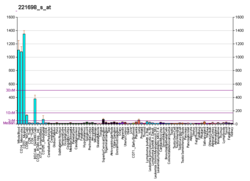Function
The C-type lectin receptors are class of signalling pattern recognition receptors which are involved in antifungal immunity, but also play important roles in immune responses to other pathogens such as bacteria, viruses and nematodes. [6] As a member of this receptor family, dectin-1 recognizes β-glucans and carbohydrates found in fungal cell walls, some bacteria and plants, but may also recognize other unidentified molecules (endogenous ligand on T-cells and ligand on mycobacteria). [6] Ligand binding induces intracellular signalling via the ITAM-like motif. CLEC7A can induce both Syk dependent or Syk independent pathways. Dimerization of dectin-1 upon ligand binding leads to tyrosine phosphorylation by Src family kinases and recruitment of Syk. Upon Syk recruitment is PKC-δ activated, which subsequently phosphorylates CARD9 that triggers recruitment of BCL10 and MALT1, leading to a CARD-CC/BCL10/MALT1 (CBM) signaling complex. [10] This signaling complex in turn triggers downstream recruitment of TRAF6 and NF-κB activation. This transcription factor is responsible for the production of numerous inflammatory cytokines [9] and chemokines such as TNF, IL-23, IL-6, IL-2. Other responses include: respiratory burst, production of arachidonic acid metabolites, dendritic cell maturation, and phagocytosis of the ligand. [11]
Antifungal immunity
CLEC7A has been shown to recognize species of several fungal genera, including Saccharomyces , Candida , Pneumocystis , Coccidioides , Penicillium and others. Recognition of these organisms triggers many protective pathways, such as fungal uptake by phagocytosis and killing via hypochlorite generation. Activation of dectin-1 also triggers expression of many protecting antifungal cytokines and chemokines (TNF, CXCL2, IL-1β, IL-1α, CCL3, GM-CSF, G-CSF and IL-6) and the development of Th17. [11]
Histoplasma capsulatum can evade recognition of β-glucan via CLEC7A on phagocytic cells by secreting an enzyme that removes exposed β-glucans or by masking the β-glucan with α-glucan. [12]
Co-stimulatory molecule
Also operating as a co-stimulatory molecule via recognition of an endogenous ligand on T-cells, which leads to cellular activation and proliferation, CLEC7A can bind both CD4+ and CD8+ T cells. [11]
This page is based on this
Wikipedia article Text is available under the
CC BY-SA 4.0 license; additional terms may apply.
Images, videos and audio are available under their respective licenses.




